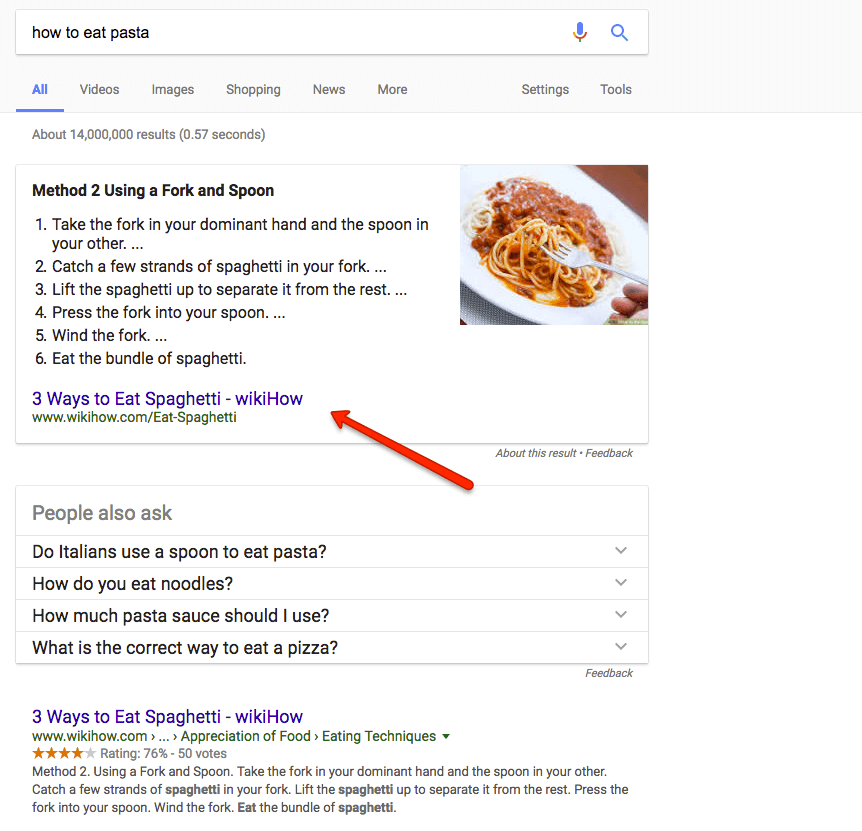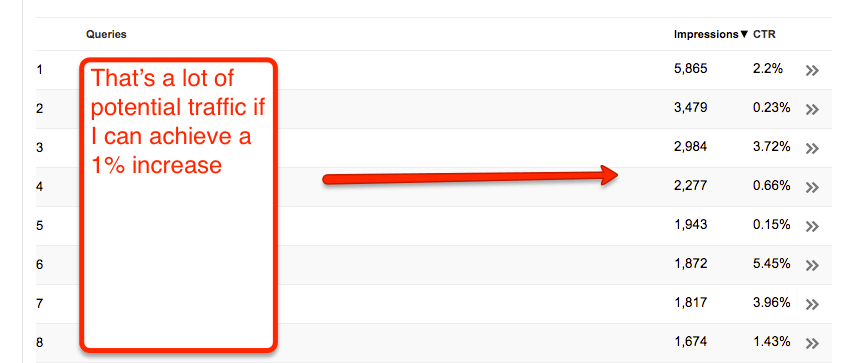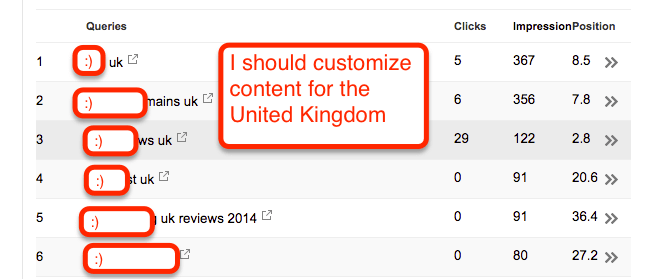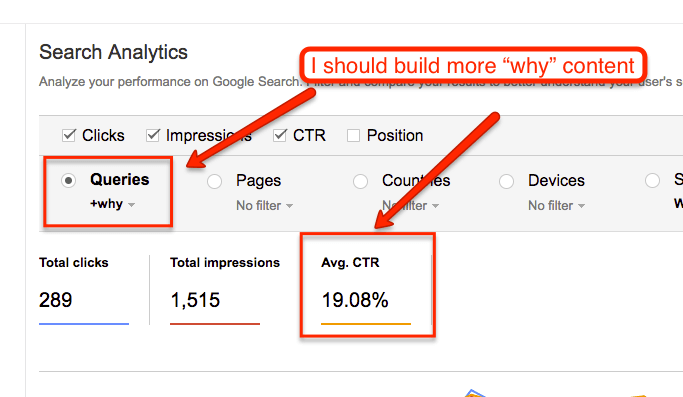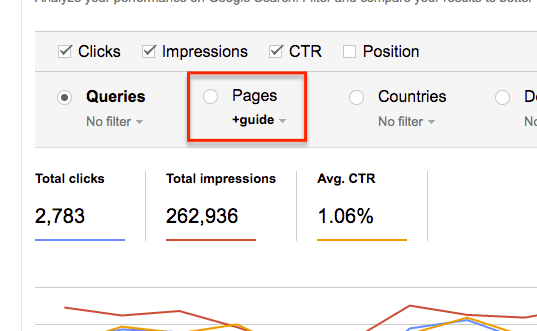Search Performance (formerly ‘Search Analytics’) is one of the most useful tools in Google Search Console’s suite of tools. It provides a lot of data about how your website is performing in Google’s organic search results.
But like any data source – it is useless…unless you know how to put the data into action. Even though the best ways to use Search Console are specific to your website, there is a myriad of ways to put the data into action.
As of 2019, Google moved an all-new Google Search Console out of Beta. You can get access at search.google.com. It is different on multiple levels from the old Webmaster Tools / Search Console. I’ve reworked all the screenshots below to reflect the current Search Console (which also renamed the Search Analytics Report to the ‘Performance’ tab.

Either way, here are 15+ ways that I like to use Search Console to solve SEO problems. Hopefully, you’ll be find something to use or build on to put your own data into action.
Search Performance Considerations
Search Console is the only place where you can get data about your website directly from Google. But as any professional SEO knows, Search Console has a few considerations to keep in mind – especially for the Search Performance.
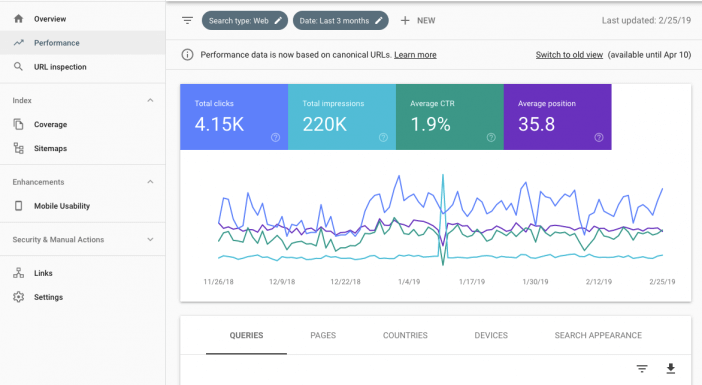
Time Limitations
Google limits the data in your dashboard to 16 months. This is much improved from the old 90 day limit. But – I still recommend making rolling backups, especially since some keywords will get cut off for some groupings.
Your backups can be as simple as downloading your keyword data every 90 days, or as complex as building software that taps into Google’s Search Console API.
Definitions
Like I mentioned in my Google Search Console guide, Google has very specific and often confusing definitions for metrics. This point is especially important in Search Performance.
Before taking action on your data, be sure that you fully understand what clicks, impressions, and positions are.
Aggregation
All the data in Search Performance is combined & sanitized data from Google. The queries that you see in Search Performance are not as trustworthy as the queries that you could see in Google Analytics before (not provided). Keep this in mind when you are creating exact projections.
Quirkiness
Google regularly announces reporting delays, infrastructure updates and error corrections for Search Console data. The data is also near impossible to confirm via 3rd party tools – though this could also simply illustrate the limitations of 3rd party tools.
There are also many documented anomalies in Search Analytics data. None of this is to say that you can’t use the data – but it is to say that you have to take the data with a grain of salt.
With that said – let’s look at these ideas!
Note – you can click on each image to load the full version.
Search Performance Ideas
Identify Reason for Increase / Decrease
In SEO, there can be thousands of reasons why a page increased or decreased in traffic. All anyone can do is create hypotheses and look for data to falsify* your hypotheses.
*you can always find data to correlate or “prove” a hypothesis. The real test is looking for data that would prove your hypothesis false (See! high school chemistry classes do matter for your marketing career) 😀
Search Performance is the first place I go to find a hypothesis worth pursuing.
Break your data down by page and/or query. Look at impressions, clicks, CTR and position. Start coming up with hypotheses to explain the increase or decrease.
Here are a few examples.
Example 1 – A single, top performing page has lost a ton of traffic in the last month. I haven’t changed a thing. It must be something external with Google or competitors. I pull up the page in Search Analytics and show the page queries with all metrics.
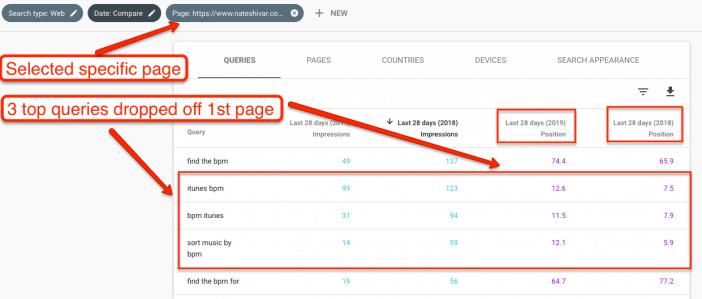
It is a broad-based slow drop. Search Impressions are down, but that doesn’t explain everything. I compare Year over Year and confirm that yes rankings have dropped some, but critically, they dropped off the top ten results.
It is partly seasonal, but I suspect that the actual SERPs have changed. I go to Keyword Planner or Ahrefs and confirm. My next steps are to revise the content to explicitly address those queries in the content. My post does not address iTunes directly, so that would be a good place to start.
Example 2 – A group of How To pages has increased traffic dramatically. I haven’t changed a thing – and haven’t had any alerts in my 3rd party rankings tools. I pull up Search Performance and group those pages.
Search impressions are the same, but my CTR and Positions are up significantly. I switch over to view queries. It looks like I’m ranking #1 for queries that start with “how to…”
I search for that query in incognito mode, and… “Ahh – I’ve gotten an Answer Box ranking due to my recent re-formatting!”
My next step is to revise all my how-to posts with that exact formatting that the new high traffic posts have.
Identify Keyword Targeting Effectiveness
You never know if your keyword targeting is right until you’ve got some data on performance. Search Console is a great place to find out what you know that you did not know (ie, what Google would pull from your new page). You can see keyword performance and revise your content for better focus.
Example – I published a new page about focusing in crowded places. It’s well-done and has been up for a month. I check Search Performance to see how it’s doing.
It’s doing ok – but not as good as I’d hoped. Additionally, the bounce rate is simply terrible.
I look at the queries and see that I’m getting weird impressions for glasses, binoculars, and eyesight.
Ahh – now I see what happened. I went a little overboard with my analogy. My catchy title of “How To Focus in Crowded Places: Binoculars, Telescopes & Mental Strategies” is not so catchy for Google.
Google thinks I’m talking about focusing binoculars in crowded places rather than focusing your mind in a crowded place by thinking like you’re using binoculars.
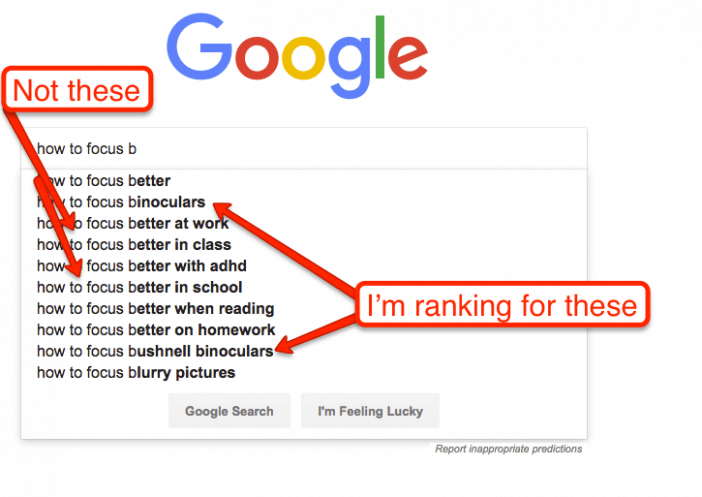
Next steps are to edit my title to be more succinct and reword my analogy to explicitly call out the context and idea. I should also revisit my keyword research and keyword difficulty.
Identify Content Revision Opportunities
A large part of search engine optimization is to optimize your content for people using search engines (rather than a social network). To do that effectively – you need to mirror & answer their needs in your content. Sometimes your content is slightly off and needs adjusting. You can look in Search Performance for clues to how you should fix it.
Look for queries on pages that are within “striking distance” – ie, queries with positions between 11 and 20 – and have modifiers that would warrant a new section or revised content.
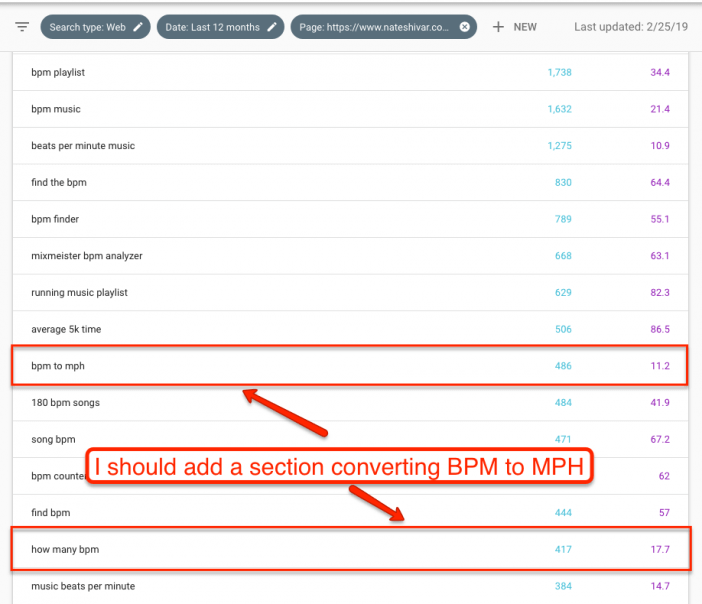
Example – let’s stick with the content about focusing in crowded places. I’m still not satisfied with how that page is doing. I look deeper at the queries coming in.
I realize that a huge number of the queries have modifiers that indicate the searcher is a student. I see queries such as “how to focus in a crowded classroom” or “focus for studying in crowded library” give a huge clue on how to revise the content to make it perform better.
For next steps, I would revise the content to speak more to students – like adding examples of libraries and studying. I could even add a section of content about dorm rooms specifically for students.
Identify New Content Opportunities
So what if you want to go beyond diagnosing & fixing existing content? You want to expand and find new ideas. I usually start with Search Performance as well.
Look at all your queries in the previous few months (or year). Find all the highest volume keywords that are outside striking distance, but ballpark relevant (ie, position 20 to 50).
Prioritize keywords that are sort of related, but not really related to your existing content. See if those queries could be adequately targeted with a new piece of content.
The idea here is that Google prizes relevance above all else. And if they are willing to show sort-of related content for a search query – then they are short of actually relevant content.
It’s the same reason that I like to look at Quora or a forum thread for content ideas. If Google has to show them for a query, then you know that Google is scraping the bottom of the barrel and will gladly show something exactly relevant.

Example – let’s keep going with our How To Focus content. I’m looking in Search Analytics and see that “meditating in public how to” is showing up. My “How To Focus in Crowded Places” is shown in position 30 for that query.
That makes no sense. My post is kinda, sorta, but not really related to meditating in public. That is a different topic entirely. But – it’s getting a 1000 impressions per month, so the search volume is legit.
My next steps would be to write a new post on How To Meditate in a Public Crowded Place.
Project Potential Keyword Volume
You can get search volume projections from a range of 3rd party tools like Ahrefs. You can also get them from Ads Keyword Planner. But here’s the thing – none of them are accurate. The not-so-dirty secret is that everyone in SEO makes educated guesses about keyword volume and expected click-through rates.
There are too many variables in play to do otherwise.
That said – you do need to know ballpark accurate numbers to justify investing in SEO. Your existing Search Performance can give you that data.
Look at Impressions for your current pages. Then drill down for each page. Use this number to extrapolate potential. Export these tables to a spreadsheet.
Determine how much more traffic could you get if you increased your CTR by 1%? How much traffic could you get if you could publish a new set of How To pages that had similar search volume? If you could keep your conversion rates the same – how much would this impact your revenue line?
These numbers are not only the most ballpark accurate – they are the simplest to access and manipulate. They shouldn’t be used to make guarantees, but they can be used to prioritize and provide some sort of anchor.
In the non-profit world, there is a concept called a “Visioning Concept.” It’s not the blueprints or even the finalized concept for the project. Instead, it’s a general sketch to help fundraisers show people what could be in order to make a more effective pitch.
Use Search Analytics to sketch out a “Visioning Concept” for how much organic traffic potential you have if you invest in the right content.
Identify CTR Opportunities
What if you could get more traffic from organic search without getting more links or improving your content? You can if you can increase the click-throughs from queries that you already appear for.
This tactic can be simple. Look for the pages and queries that have high impressions and low CTR. Figure out if most of your queries have positions above 11. If they aren’t, then you need to revise or create new content. If they are above 11, then you can experiment with editing your meta description and titles to entice more clicks.
If your target terms have Answer Box, then you can reformat part of your post to grab that ranking.
Either way, Search Analytics will tell you how to prioritize your efforts.
Identify Successful / Failing Outliers
In any field, outliers from the statistical average can tell you a lot about what tactics are truly successful. In other words, if you want to be a successful basketball player, don’t observe what NBA players who are 6’10” children of basketball coaches do. Instead, observe what the 5’8” players who picked up a basketball in high school do.
In Search Analytics, you can quickly see what metrics and dimensions are outliers. Which queries or pages are performing well in spite of a lack of links, content, etc? Which queries or pages are mediocre despite heavy investment?
What can you learn from those data points? What are the best practices for your website?
In SEO, there are a ton of “best practices” – but many can vary wildly depending on industry, competition and more. Don’t trust tips that preach long-form content if your outliers are short-form content – and vice versa.
Identify Geographic Opportunities
I work from Atlanta, GA in the USA. I will be the first to admit that I write with a US reader in mind even though the US only makes up half my traffic. I have visitors from every country in the world at least every month. Only recently have I begun to make changes to prioritize my non-US visitors – and I have missed a lot of opportunities by waiting.
But even if you are a nationally (or locally) focused company – you are likely missing opportunities because of your geographic bias.
The thing is that we prioritize our local reader or customer because it is hard to be specific otherwise. You can’t prioritize “the world” or “the US” – but Search Performance changes that.
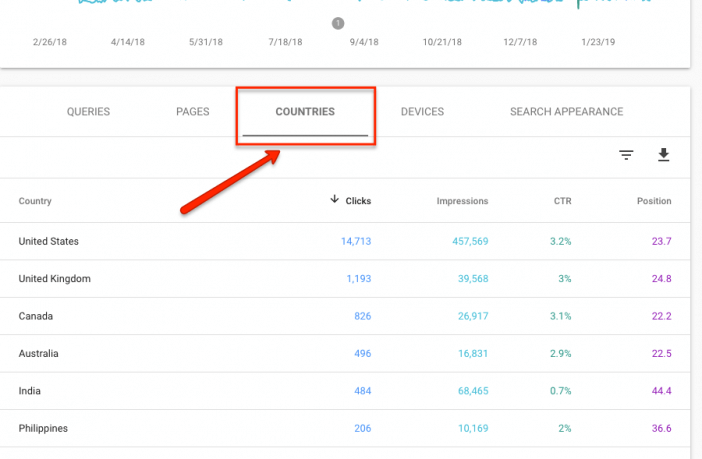
You can do a couple of things in Search Analytics.
First, you can sort all the previous ideas by geography. If America makes up 100% of your “How To Focus” audience – then you can comfortably revise it to fit them.
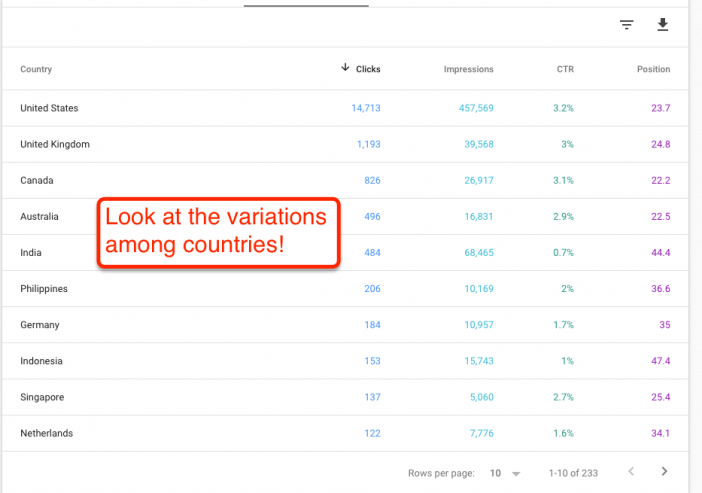
Second, you can sort queries by geographic intent. Like the Creating New Content section – if you have enough queries with geographic intent, then you should explore creating content for that geographic location.
People love their place, even if their place does not technically matter. And even if you can’t appeal to local intent, you definitely can lock up your home market (ie, “email marketing Atlanta, GA”).
Look for Rich Snippet Opportunities
Rich snippets are a catch-all term for results with additional information beyond what appears by default in Google’s search results pages (SERPs). Whether it is stars, cook times, event details, etc – they can have a huge impact on your click-through rate.
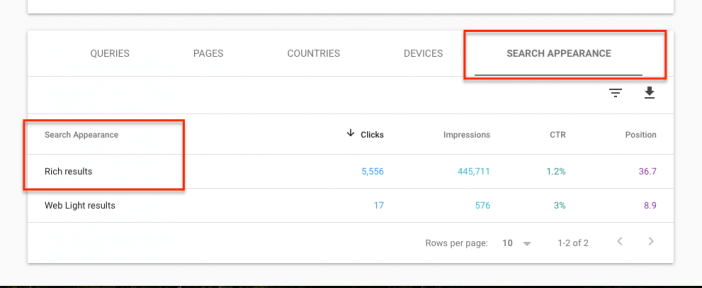
You can diagnose how you are doing and where you can do better with Search Analytics. Be sure to look for outliers in order to diagnose what you are doing right or wrong with different pieces of content.
Look for Mobile Opportunities
“Opportunity” and “mobile” have been near-synonymous for years now. And you can use Search Performance to segment by device.
With this report, you can look at performance on mobile vs. desktop. But – I argue that that will not tell you much. You already know what you need to do with your website – it needs to be mobile-friendly.
But what is more interesting in Search Performance is to see how queries shift based on device. Mobile queries are often structured differently and have slightly different needs than desktop queries.
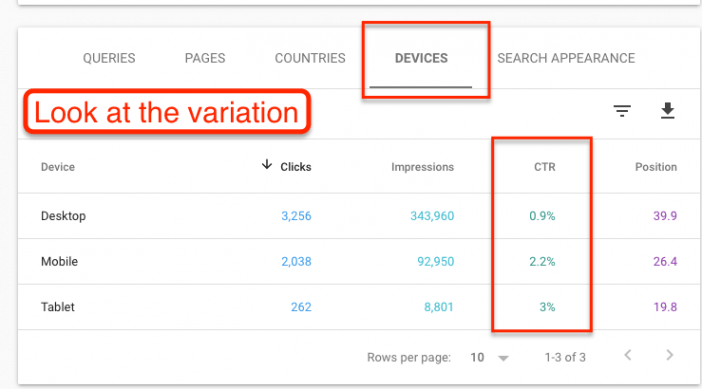
This data can help you take “mobile-friendly” beyond simply resizing your content.
For example, think about your About page. You might want to use it to tell your story and build trust with your visitors. But – if it ranks on mobile for [your business location] – you need to either create a location page or revise your About page to include location right at the top.
Because if someone is searching for [your business location] on their mobile device – they want that information *now* without scrolling or dealing with your story.
Identify Successful Keyword Footprints
When you are scoping new content opportunities, you can use Search Performance to figure out entire classes of content that do well.
Instead of looking for 1 or 2 striking distance keywords, search Search Performance for keyword footprints like “how to” or “why” or any sort of broad keyword.
Take that keyword footprint and use it to focus your keyword research elsewhere. For example, if I know that I do especially well with “how to” posts – then I can use that to narrow my research on Ahrefs, Reddit, Pinterest, Wikipedia, Quora, Slideshare or any other content idea source.
Identify Successful Page Types
On the same thread as successful keyword footprints – it also pays to look at successful page types. Narrow your pages by some sort of footprint and look for commonalities.
For example, if you are eCommerce store, take all your category or brand pages to see how their position and impressions perform over time.
Identify Traffic Quality w/ Google Analytics Connection
If you haven’t linked Google Search Console with Google Analytics, then you should do that now. Even though you still won’t be able to see keyword level engagement data – you will be able to perform faster analysis with the data you do have.
Take your Landing Pages and look at bounce rate, time on page and, most importantly, conversion rate. Use these data points to triangulate how well your keyword & content effectiveness is.
Identify Traffic Engagement w/ Google Analytics Connection
You can also explore the data from Search Console and Analytics in reverse to figure out why pages have poor engagement.
For example, you can use the query report to see if your content matches user intent or device usage. If it doesn’t then that likely explains your high bounce rate.
Find Paid Search Opportunities
Paid search advertising can be expensive. If you start with a broad net and narrow down to profitable keywords, then you’ll likely need a pretty significant budget to burn & test before you get profitable.
But – if you need some quick wins or if you want to get more visibility for key terms, then you can take query data from successful pages and port them to Google Ads.
For example, suppose you have a product page that does well with generic keywords. It ranks, on average, between 4 and 5 organically. But – you know from your Analytics that the traffic you do get converts *really* well.
You can export the queries from that page, wrap them in an exact phrase match type, and add them to Google Ads. You’ll be able to buy your way to the top.
This will do three things –
- You’ll likely increase the click-through rate for both your ad and organic results since you have a high presence on the page.
- You will be able to get incremental new sales and new traffic from the paid ad.
- You will be able to judge the potential return on investment for ranking #1 organically on that theme of keywords.
Next Steps
The best way to truly learn how to use data is to manipulate it as much as you can for yourself.
These ideas are only the tip of the iceberg. Head over to Search Console, think of a question and then manipulate the data until you have an answer. Also – be sure to use the export to spreadsheet feature.
Have fun – and don’t forget to backup your data 😉
Read more about 5 Free Beginner SEO Tools From Google & How to Use Them.
